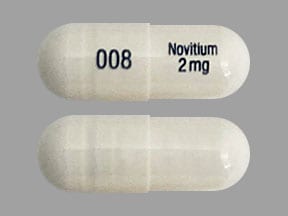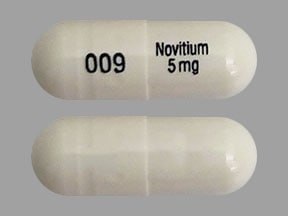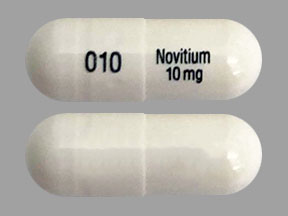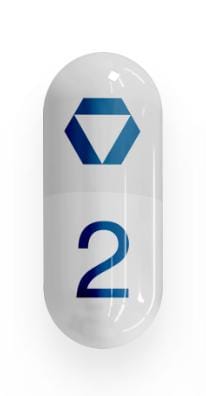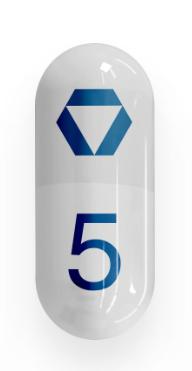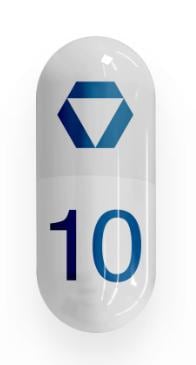Dosage Forms
Excipient information presented when available (limited, particularly for generics); consult specific product labeling.
Capsule, Oral:
Orfadin: 2 mg, 5 mg, 10 mg, 20 mg
Generic: 2 mg, 5 mg, 10 mg
Suspension, Oral:
Orfadin: 4 mg/mL (90 mL) [contains polysorbate 80, sodium benzoate]
Tablet, Oral:
Nityr: 2 mg, 5 mg, 10 mg
Pharmacology
Mechanism of Action
In patients with HT-1, tyrosine metabolism is interrupted due to a lack of the enzyme (fumarylacetoacetate hydrolase) needed in the last step of tyrosine degradation. Toxic metabolites of tyrosine accumulate and cause liver and kidney toxicity. Nitisinone competitively inhibits 4-hydroxyphenyl-pyruvate dioxygenase, an enzyme present early in the tyrosine degradation pathway, thereby preventing the build-up of the toxic metabolites.
Pharmacokinetics/Pharmacodynamics
Distribution
Vd: Healthy volunteers: 8.2 L
Metabolism
Minor metabolism possibly via CYP3A4
Excretion
Healthy volunteers: Urine (3% unchanged) (Hall 2001)
Time to Peak
Healthy volunteers:
Capsule:
Single 30 mg dose: Median: 3.5 hours (range: 0.8 to 8 hours)
Multiple 80 mg doses: Median: 4 hours (range: 0 to 16 hours)
Suspension: Single 30 mg dose: Median: 0.4 hours (range: 0.2 to 4 hours)
Tablet: Single 10 mg dose: Median: 3.5 hours (range: 1 to 4 hours)
Half-Life Elimination
Healthy volunteers: Terminal half-life: Capsule, suspension: 54 hours; Tablet: 59.3 hours
Protein Binding
>95%
Use: Labeled Indications
Hereditary tyrosinemia type 1: Treatment of hereditary tyrosinemia type 1 (HT-1) as an adjunct to dietary restriction of tyrosine and phenylalanine in adult and pediatric patients.
Contraindications
There are no contraindications listed in the manufacturer's labeling.
Canadian labeling: Additional contraindications (not in US labeling): Hypersensitivity to nitisinone or any component of the formulation; breastfeeding
Dosage and Administration
Dosing: Adult
Note: Must be used in conjunction with a diet restricted in tyrosine and phenylalanine. Titrate dose as needed based on biochemical and/or clinical response. If the biochemical response is satisfactory, the dosage should be adjusted only according to body weight gain. Do not adjust dose according to plasma tyrosine concentration.
Hereditary tyrosinemia type 1 (HT-1): Oral: Initial: 0.5 mg/kg twice daily. Increase to 0.75 mg/kg twice daily if succinylacetone is detectable 4 weeks after initiation. Further increase may be needed based on the evaluation of all biochemical parameters (maximum dose: 2 mg/kg/day); dose may be administered once daily (eg, 1 to 2 mg/kg once daily) if serum and urine succinylacetone is undetectable after ≥4 weeks of therapy.
Dosing: Geriatric
Refer to adult dosing.
Dosing: Pediatric
Note: Must be used in conjunction with a diet restricted in tyrosine and phenylalanine. If using tablets, round calculated dose up to the nearest available tablet strength.
Hereditary tyrosinemia type 1 (HT-1): Infants, Children, and Adolescents: Oral: Initial: 0.5 mg/kg/dose twice daily; titrate dose individually based on biochemical markers (eg, plasma and/or urine succinylacetone concentrations, liver function parameters and alpha-fetoprotein concentrations) and clinical response. If succinylacetone concentrations are still detectable after 1 month of therapy, may increase dose to 0.75 mg/kg/dose twice daily; may further increase as needed up to a maximum of 1 mg/kg/dose twice daily; maximum daily dose: 2 mg/kg/day. Once the biochemical response is satisfactory, further dosage adjustments should be only according to body weight gain; in patients ≥5 years using capsules or oral suspension, daily dose may be transitioned to once daily (eg, 1 to 2 mg/kg/dose once daily) if serum and urine succinylacetone is undetectable after ≥4 weeks of stable therapy.
Reconstitution
Suspension: Refer to manufacturer's product labeling for preparation instructions. Allow suspension to warm to room temperature (30 to 60 minutes). Shake vigorously for 5 seconds (bottles with adapter inserted) or 20 seconds (bottles without the adapter inserted); foam will form.
Administration
Capsules: Administer at least 1 hour prior to, or 2 hours after a meal. Capsules may be opened and contents suspended in a small quantity of water, formula, or apple sauce; administer immediately.
Suspension: Administer without regards to meals. Allow suspension to warm to room temperature (30 to 60 minutes) prior to preparation.
Tablets: Administer without regards to meals. Tablets may be disintegrated in water and administered using an oral syringe or crushed and mixed with applesauce (administration with other liquids or foods is not recommended [has not been studied]). Refer to manufacturer's labeling for detailed instructions.
Dietary Considerations
Nitisinone capsules should be taken at least 1 hour prior to, or 2 hours after a meal. Dietary restriction of tyrosine and phenylalanine is required.
Storage
Capsules: Store refrigerated at 2°C to 8°C (36°F to 46°F). May store at room temperature (up to 25°C [77°F]) for up to 45 days; discard capsules if not used within 45 days.
Suspension: Store refrigerated at 2°C to 8°C (36°F to 46°F) prior to first use. After opening, store at room temperature (up to 25°C [77°F]) for up to 60 days. Do not freeze.
Tablets: Store at 20°C to 25°C (68°F to 77°F); excursions permitted to 15°C and 30°C (59°F and 86°F).
Nitisinone Images
Drug Interactions
Bosentan: CYP2C9 Inhibitors (Moderate) may increase the serum concentration of Bosentan. Management: Concomitant use of both a CYP2C9 inhibitor and a CYP3A inhibitor or a single agent that inhibits both enzymes with bosentan is likely to cause a large increase in serum concentrations of bosentan and is not recommended. See monograph for details. Monitor therapy
Cannabis: CYP2C9 Inhibitors (Moderate) may increase the serum concentration of Cannabis. More specifically, tetrahydrocannabinol serum concentrations may be increased. Monitor therapy
Carvedilol: CYP2C9 Inhibitors (Moderate) may increase the serum concentration of Carvedilol. Specifically, concentrations of the S-carvedilol enantiomer may be increased. Monitor therapy
CYP2C9 Substrates (High risk with Inhibitors): CYP2C9 Inhibitors (Moderate) may decrease the metabolism of CYP2C9 Substrates (High risk with Inhibitors). Monitor therapy
Dichlorphenamide: OAT1/3 Inhibitors may increase the serum concentration of Dichlorphenamide. Monitor therapy
Diclofenac (Systemic): CYP2C9 Inhibitors (Moderate) may increase the serum concentration of Diclofenac (Systemic). Management: Consider using a reduced dose of diclofenac when used together with moderate CYP2C9 inhibitors. Arthrotec (diclofenac and misoprostol) prescribing information recommends a maximum dose of 50 mg twice daily. Consider therapy modification
Dronabinol: CYP2C9 Inhibitors (Moderate) may increase the serum concentration of Dronabinol. Monitor therapy
Lesinurad: CYP2C9 Inhibitors (Moderate) may increase the serum concentration of Lesinurad. Monitor therapy
Lornoxicam: CYP2C9 Inhibitors (Moderate) may increase the serum concentration of Lornoxicam. Monitor therapy
Meloxicam: CYP2C9 Inhibitors (Moderate) may increase the serum concentration of Meloxicam. Monitor therapy
Nateglinide: CYP2C9 Inhibitors (Moderate) may increase the serum concentration of Nateglinide. Monitor therapy
OAT1/3 Substrates: Nitisinone may increase the serum concentration of OAT1/3 Substrates. Monitor therapy
Siponimod: CYP2C9 Inhibitors (Moderate) may increase the serum concentration of Siponimod. Monitor therapy
Tetrahydrocannabinol: CYP2C9 Inhibitors (Moderate) may increase the serum concentration of Tetrahydrocannabinol. Monitor therapy
Tetrahydrocannabinol and Cannabidiol: CYP2C9 Inhibitors (Moderate) may increase the serum concentration of Tetrahydrocannabinol and Cannabidiol. Specifically, concentrations of tetrahydrocannabinol may be increased. Monitor therapy
Torsemide: CYP2C9 Inhibitors (Moderate) may increase the serum concentration of Torsemide. Monitor therapy
Adverse Reactions
>10%:
Endocrine & metabolic: Increased plasma tyrosine
1% to 10%:
Dermatologic: Alopecia (1%), exfoliative dermatitis (1%), maculopapular rash (1%), pruritus (1%), xeroderma (1%)
Endocrine & metabolic: Porphyria (1%)
Hematologic & oncologic: Leukopenia (3%), thrombocytopenia (3%), granulocytopenia (1%)
Hepatic: Hepatic failure (7%), hepatic neoplasm (malignant: 5%; benign: 3%)
Ophthalmic: Conjunctivitis (2%), corneal opacity (2%), keratitis (2%), photophobia (2%), blepharitis (1%), cataract (1%), eye pain (1%)
Respiratory: Epistaxis (1%)
<1%, postmarketing, and/or case reports: Abdominal pain, brain disease, brain neoplasm, bronchitis, corneal ulcer, cyanosis, diarrhea, enanthema, gastric distress, gastrointestinal hemorrhage, headache, hepatomegaly, hyperkinesia, hypoglycemia, increased liver enzymes, melena, seizure, septicemia
Warnings/Precautions
Concerns related to adverse effects:
- Dermatologic effects: Failure to adequately restrict dietary tyrosine and phenylalanine may lead to hyperkeratotic plaques on the soles and palms.
- Hematologic effects: Leukopenia and/or thrombocytopenia have been reported; may improve with dose reduction. May be due to underlying liver disease rather than drug-related (McKiernan 2006). Monitor platelets and WBC regularly during therapy.
- Neurological effects: Failure to adequately restrict dietary tyrosine and phenylalanine may lead to variable degrees of intellectual disability and developmental delay; clinical laboratory assessment including tyrosine levels is recommended for any patient exhibiting abrupt changes in neurological status while on therapy.
- Ocular effects: Failure to adequately restrict dietary tyrosine and phenylalanine may lead to ocular toxicities (eg, conjunctivitis, corneal ulcers, corneal opacities, eye pain, keratitis, photophobia). Slit-lamp examination of the eyes is recommended prior to initiation of therapy and regularly thereafter, and in patients who develop photophobia, eye pain, tyrosine levels >500 mcmol/L, or signs of inflammation (eg, redness, swelling, burning of the eyes). Immediate measurement of plasma tyrosine concentration is also recommended in patients who develop ocular symptoms.
Dosage form specific issues:
- Glycerol: Oral suspension contains 500 mg/mL of glycerol; oral doses of glycerol ≥10 g may cause headache, upset stomach, and diarrhea. Patients receiving single doses >20 mL are at increased risk for these adverse reactions; consider switching patients unable to tolerate the oral suspension to nitisinone capsules.
Other warnings/precautions:
- Dietary restrictions: Must be used with dietary restriction of tyrosine and phenylalanine; inadequate restriction can result in toxic effects to the eyes, skin, and nervous system. Evaluate plasma tyrosine concentrations in patients who develop signs and symptoms of toxicity. Nutritional consultation is recommended.
Monitoring Parameters
Dietary tyrosine and phenylalanine (assess dietary intake with tyrosine concentrations >500 mcmol/L); urine and/or plasma succinylacetone, liver function parameters, and alpha-fetoprotein levels (in addition, at initiation or if there is a deterioration of the patient's clinical condition, may also monitor urine 5-aminolevulinate and erythrocyte porphobilinogen-synthase activity); body weight; slit-lamp examination (prior to initiation of therapy and regularly thereafter, and in patients who develop symptoms of ocular toxicity); plasma tyrosine (as clinically indicated with side effects; concentrations should be kept <500 mcmol/L to avoid toxicity); platelet and white blood cell counts (regularly during therapy).
Note: Plasma succinylacetone may take up to 3 months to normalize after start of therapy.
Pregnancy
Pregnancy Considerations
Adverse events have been observed in animal reproduction studies.
Patient Education
What is this drug used for?
- It is used to treat hereditary tyrosinemia type 1 (HT-1).
Frequently reported side effects of this drug
- Headache
- Nausea
- Diarrhea
Other side effects of this drug: Talk with your doctor right away if you have any of these signs of:
- Liver problems like dark urine, feeling tired, lack of appetite, nausea, abdominal pain, light-colored stools, vomiting, or yellow skin or eyes
- Skin changes on extremities
- Vision changes
- Eye pain
- Severe eye irritation
- Light sensitivity
- Confusion
- Chills
- Sore throat
- Bleeding
- Bruising
- Signs of a significant reaction like wheezing; chest tightness; fever; itching; bad cough; blue skin color; seizures; or swelling of face, lips, tongue, or throat.
Note: This is not a comprehensive list of all side effects. Talk to your doctor if you have questions.
Consumer Information Use and Disclaimer: This information should not be used to decide whether or not to take this medicine or any other medicine. Only the healthcare provider has the knowledge and training to decide which medicines are right for a specific patient. This information does not endorse any medicine as safe, effective, or approved for treating any patient or health condition. This is only a brief summary of general information about this medicine. It does NOT include all information about the possible uses, directions, warnings, precautions, interactions, adverse effects, or risks that may apply to this medicine. This information is not specific medical advice and does not replace information you receive from the healthcare provider. You must talk with the healthcare provider for complete information about the risks and benefits of using this medicine.
